 ISSN : 1598-2920
ISSN : 1598-2920
Purpose The purpose of this study was to analyze the effect of push-up plus exercise(PUPE) on stabilization of the scapula and to use it as basic data for shoulder rehabilitation program. Methods In this study, research papers were collected using Research Information Sharing Service(RISS) and Pub-Med Central.(PMC) as a search term for scapular stabilization, push - up plus, shoulder joint injury rehabilitation and scapular stabilization exercise. Also, it was used as basic data of literature analysis. The collected data were classified into the structure and movement of the scapula and shoulder, kinesiologic relation of the scapula and the mechanism of injury, and the effect of push-up plus Results Serratus anterior is a typical stabilizing muscle, and it forms a force couple with the upper and lower trapezius to control the movement of the scapula. The PUPE is an effective exercise method to selectively strengthen serratus anterior, which are the stabilizing muscles of the scapula, and is an exercise method that is also useful for correcting the wrong postures and movements because of hypertonus upper trapezius. In addition, various conditions such as application posture, arm position, and ground instability were suggested during PUPE. Conclusion The results of this study confirmed that PUPE is an effective program for scapula stabilization in the rehabilitation of shoulder injuries and injured patients and athletes. The PUPE will be used as a rehabilitation exercise program for patients and athletes who need rehabilitation of the shoulder joint.

Purpose The purpose of this study is to investigate the effects of grip width and hand orientation on muscle activities of upper body during the lat pull-down. Methods Eight healthy men performed the 6 grip variations (3 grip width × 2 hand orientation) using an experimentally determined load of 70% of 1 repetition maximum. Five trials were analyzed for each grip type. Participants maintained a cadence of 2-second concentric and 2-second eccentric phases. The grip widths were normalized for each individual by using their biacromial diameter (100%), and then set the grip width 50% of biacromial diameter and 150% of biacromial diameter. Surface EMG of the latissimus dorsi, pectoralis major, infraspinatus, biceps brachii, triceps brachii, rectus abdominis, erector spinae and middle trapezius was recorded, and the root mean square of the EMG was normalized, using a maximum isometric voluntary contraction. Results Latissimus dorsi showed higher muscle activities in 100% grip width than those of 50% grip width. Pectoralis major and rectus abdominis showed higher muscle activities in 50% and 100% grip width than those of 150% grip width. Middle trapezius showed higher muscle activities in 150% grip width than those of 50% grip width. Conclusions Two-way repeated measures ANOVA for each muscle revealed that latissimus dorsi and middle trapezius (the posterior muscles of trunk) showed higher muscle activities in wide grip, on the other hand, pectoralis major and rectus abdominis (the posterior muscles of trunk) showed higher muscle activities in narrow grip.



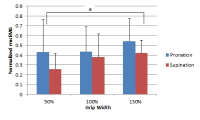


Purpose This study examines the regional differences in fall-related physical fitness and fall experience characteristics between Korean and Japanese elderly people. Methods The study includes 176 elderly residents of Gifu(35 male, 73.5yrs; 141 female, 72.4yrs) and 147 residents of Ulsan(46 male, 75.6yrs; 101 female, 75.6yrs). One-legged stance, hand grip strength, knee extension strength, 10 m gait, timed up and go test, 30-s chair stand, sit and reach, and reaction time were measured to examine the fall-related physical fitness. A questionnaire survey was also conducted to investigate the characteristics of the fall experiences. Results The elderly in Ulsan experienced a lot of falls compared to those in Gifu. Many of the fallers in Ulsan have fallen forward due to tripping, and they have often fallen backwards by losing balance. In addition, 14% of them suffered a bone fractured. The one-legged stance, hand grip strength, 10m gait, timed up and go, 30-s chair stand, and reaction time of the elderly in Gifu were superior to those in Ulsan. Conclusion In order to reduce the fall rate through improvements to fall related physical fitness and the awareness of fall prevention, various professional fall prevention programs and policies should be proposed, and they should be implemented systematically for community living elderly people.

Purpose This study was to investigate the systematic application of the life skills program and its effects in a sport setting. Methods Participants were 14 college students(8 males and 6 females) majoring in Taekwondo. Survey tools were utilized to measure items of life skills and journals. Data analyses were conducted by using Excel program and inductive content analysis. Results First, life skills in this study consisted of goal setting, self-talk, imagery, cognitive restructuring. Life skills program has undergone a procedure, such as the introduction, training, development, application, and evaluation. Second, the average scores of life skill variables have been changed according to measured points. Specifically, the average scores of goal setting and self-talk were highly increased over time and the average score of imagery indicated gradual rising line. The average score of negative thought was slightly reduced over time. Third, regarding effects of this program, participants’ responses were categorized into six components; performance enhancement, positive thoughts, chances of change, goal setting, struggling efforts, and motivation formation. Further, participants stated this program was a great opportunity to develop these components. Conclusion The application of life skills program in sport settings will contribute to participants’ life span developmental change in cognitions, emotions, and behavior.


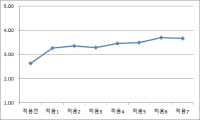

Purpose The purpose of this study is to examine the socio-cultural background and the current issues of camp training system. This work could find the reason why camp training is continuing despite the regulatory policy. Methods This study compared past national and social situation, sports and education policies of each government, and the changes of sports paradigm through literature review. Results The settlement background of camp training system was explained by the national situation in 1970s and the elite sports policy. However, after the political democratization, the human rights ideology as universal value has developed, and the anti-human rights system which individuals sacrifice for the realization of community became not free in the school sports. Especially, since the 2000s, various social problems caused by camp training have been discussed and the school sports system is undergoing transition under various regulation. In this process, the conflict between the policy makers and the subjects is intensifying. The partial regulation, rather than radical reform, has been the cause of conflict without resolving 'the remnants of past elite sport policy'. The current regulation is limited to the "partial regulatory system", omitting fundamental changes such as the revision and abolition of the student-athletes' college entrance system. Conclusion This study presented two issues to normalize school sports. First, it is necessary to discuss the revision or abolishment of the student-athletes' college entrance system. Second, the existing school athletic system should be transformed into a future-oriented club system. By solving these problems, we can expect the policy effectiveness of current regulation and it will be able to reach the future that the regulatory policy are aiming at.

Purpose The purpose of this research was to investigate the influence of professional baseball teams' message appeal type (emotional vs. rational) and message delivery method (article with photo vs. article without photo) on consumers' acceptance of the message. The hypotheses were two folds. First, compared with a rational apology article, a professional team's emotional apology article affected consumers' acceptance more positively. Second, a professional team's apology article with a photo attached influenced consumers' acceptance more positively than one without a photo. Methods To achieve the purpose of this study, the authors utilized a 2 (Message Appeal Type: emotional vs. rational) × 2 (Message Delivery Method: article with photo vs. article without photo) factorial experiment. An existing baseball team was selected and was assumed to have been involved in a game fixing situation. Out of 340 participants, 325 were used in the final analysis. Two-way ANCOVA of SPSS 23.0 was conducted to analyze the data. Results Findings revealed when a professional baseball team issued an emotional apology article, consumers were more positive about it than a rational one. Also when a professional team delivered an article with a photo, consumers accepted the article more positively than the one without a photo.



Purpose In recent years, competition among companies has become more and more important to maximize the competitiveness of companies by improving their productivity through technological innovation. Increasing competitiveness through technological innovation is becoming an essential requirement for survival of companies. In order for companies to innovate, it is necessary to spend R&D investment and the government is strengthening various policy supports to do this. Athletic equipment industry classified as manufacturing industry in sports industry. In this study, considering the fact that manufacturing industry occupies a large part of Korea's R&D investment, we compared R&D intensities with athletic equipment industry and other industries. We also examined whether R&D investment has affected firm performance. Methods The data used in the analysis were extracted from KIS-DATA with KSIC codes of companies classified as sports and athletic goods manufacturing industry in the 9th Korean Standard Industrial Classification of National Statistical Office. The analysis period is five years from 2011 to 2015 to look at the current status. Looking at the number of companies extracted by year, it was 42 in 2011, 45 in 2012, 46 in 2013, 48 in 2014, and 39 in 2015. Results Research showed that the intensity of R&D of athletic equipment industry was 1.22% in 2011, 1.63% in 2012, 1.51% in 2013, 1.53% in 2014 and 1.30% in 2015. This was lower than the manufacturing industry, which was a category of athletic equipment industry, and lower than that of similar small and medium sized enterprises. The correlation between R&D intensities and the sales growth rate of firms showed a positive correlation in 2011 and 2015, but the correlation is not strong. Conclusion R&D investment in athletic equipment industry was not actively taking place, and R&D investment did not have a significant effect on the performance of the company.

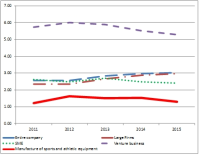

Purpose The purpose of this study is to empirically inquire into the relationship between a commercial sports center employee's humor orientation & customer orientation and employees' trust, service quality, sports center relationship quality and relationship retention through structural equation model analysis. Methods For this purpose, the survey targeted 224 adult men and women who have used any one of the three commercial sports centers in Chungcheong for over three months. For sampling method, convenience sampling method was used, while the questionnaire was self-administered. In an effort to verify the proposed structural model, this study used IBM SPSSWIN Ver. 21.0 and AMOS 18.0. Results First, humor orientation was found to have a positive influence on employees' trust. Second, customer orientation was found to have a positive influence on employees' trust. Third, employees' trust was found to have a positive influence on service quality. Fourth, employees' trust was found not to have a positive influence on sports center relationship quality. Fifth, employees' trust was also found not to have a positive influence on relationship retention. Sixth, service quality was found to have a positive influence on sports center relationship quality. Seventh, service quality was also found not to have a positive influence on relationship retention.


Purpose The purpose of this study was to verify the importance and satisfaction of service quality of visitors to screen baseball using the Importance-Performance Analysis. Methods Selected visitors who participated in screen baseball using convenience sampling of non-probability sample method from January 26 to May 27, 2017, and conducted a questionnaire survey to a total of 213 data were used in this study except 17 data which were untrustworthy responses or non-responses. SPSS 21.0 statistical program were used to exploratory factor analysis, reliability analysis, frequency analysis and IPA. Results The results were as follows. first of all,Ⅰquadrant derives 7 items including modernized facilities and equipments. Next, Ⅱ quadrant, there are 5 credibility of the program and continuous service provision. Also, in the quadrant Ⅲ, the service promised to the customer and the interest and effort of the staff in case of trouble were confirmed.. In the quadrant IV, four items were analyzed such as the interest in the members and the matching of the members' use time. In the analysis of Slack's(1994) diagonal model, twelve kinds of improvements such as costumes, appearance, internal facilities and services promised to customers were derived. In addition, there are 5 appropriately provided properties such as modern facilities and equipment, and facilities suitable for enjoying baseball. Finally, in the attributes that are provided in excess, four attributes are indicated, attention to members and matching of members' use time. Conclusion Based on the results of this study, it is meaningful to be a marketing and management practice data for operating the screen baseball.

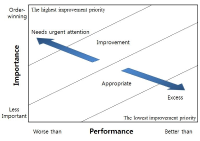



Purpose The purpose of this study is to grasp consumers' perception of badminton racket brand image using MDS and ISA. Methods To do this, we conducted questionnaires on those who participated in badminton and had experience of participating for 6 months or more in Seoul and Gyeonggi province from April 12 to 28, 2017, selected and analyzed a total of 313 copies as valid samples of this study. Results The results of study are as follows. First, as a result of MDS analysis, it showed that only the price of brand image attributes were in order of Trion > Joobong > Lining > Victor > Yonex, and the other attributes(Design, Functionality, Quality, Awareness, Advertising image, Event, Color, Popularity, Sophistication, Originality, Trust, Service) were in order of Yonex > Victor > Lining > Joobong > Trion. Second, as a result of ISA analysis, in I quadrant, Yonex showed functionality, quality, sophistication, and trust and Trion showed price, design, functionality and quality, Victor showed price, design, functionality, quality, color, sophistication, trust, service, and Joobong showed price, functionality, quality, and trust in this area. In quadrant Ⅱ as concentrated area, Yonex showed price and service, Trion showed color, trust, service, Victor showed price, Lining showed trust and service, and Joobong showed service in this area. In quadrant Ⅲ as low rank, Yonex showed advertising image, event, Trion showed awareness, advertising image, event, popularity, sophistication, originality, Victor showed advertising image, event, popularity, originality, Lining showed awareness, advertising image, event, popularity, originality, and Joobong showed design, advertising image, color, popularity, sophistication in this area. In quadrant IV as excess avoidance, Yonex showed design, awareness, color, popularity, originality, Victor showed awareness, Joobong showed awareness, event, originality in this area.



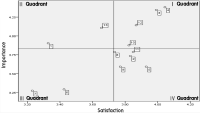




Purpose The purpose of this study is to find effective skin scuba activation factors and to provide basic data that extend the scope of research related to skin scuba. Methods Delphi method was used and the experts were categorized by experts to analyze the results. The questionnaires collected through the 2nd and 3rd delphi surveys were SPSS win ver. 22.0 and Microsoft Office Excel 2013 to calculate mean, standard deviation, median, and coefficient of variation. The concrete conclusions are as follows. Conclusions First, in terms of organization sub-factor, fostering sports-for-all participants and college club came out to be very effective and followed by cooperation system with Ministry of Public Safety and Security and Ministry of Oceans and Fisheries, strengthening cooperation and exchange with other education organizations, initializing new scuba diving education organization management and inspection institution and establishing scuba diving education organization. Second, in terms of facility/equipment sub-factor, factors that cause most effectiveness came out as expanding scuba-diving installation, developing connection system with medical department, enlarging indoor-diving education facilities, improving scuba diving equipment, consecutively. Third, in terms of leader sub-factor, training instructor through leader personality education and verification came out to be the most effective, followed by objectifying professional education institution leader training system, improving leader treatment. Fourth, in terms of program sub-factor, it is found that safety education program as the most effective factor, coming next with environment education/professional manpower training program, developing various programs, lastly, inventing insurance product. Fifth, in terms of advertisement sub-factor, as in order of guiding publics to change their view towards scuba-diving, expanding scuba-diving related events and establishing advertisement system had its effectiveness. Sixth, in terms of policy sub-factor, establishing cooperation system among administration departments came out to be most effective and then improving related law-system.
Purpose The purpose of this study is to examine the elite sport system in Germany by selecting six keyword. Methods In order to review the literature, we reviewed the reports of sports organizations such as the Ministry of the Interior, the Olympic Games of Germany, the Sports Council of Germany, and the German sports policy, history, business, programs and financial status. Conclusion In Germany, athletic associations were created in the 40s and 50s and strengthened infrastructure, projects, and workforce infrastructure by the 60s and 90s. Through its long history and tradition, Germany is at the forefront of both the Winter and Sommer Olympics. Among them, the German Olympic Sports Federation, researchers Institute, Olympic training centers, Sports School, Kader-systems and federal police·military·customs are the main keyword of elite sports. In order to support the national players in Germany, the regional Olympic training center supports sports science, sports gymnasium, sports athletic high school, sports elite school, athletes' house are operated for selection and training of excellent athletes. And all the players are in the carder system and there is a system that allows them to enter the federal police, soldiers and customs so that they can support the human resources, facilities and programs as well as train and work at the same time.

Purpose This study was to explore construct of fear and courage behavior overcoming the fear and relationship between fear and courage in competition. Methods Total 65 national athletes of combat sports(Judo, Boxing, Taekwondo, Fencing) responded to open questionnaire about fear and courage behavior in competition. The data was analyzed by triangle verification and content analysis. Results Firstly, the fear of combat sports athletes consisted of five factors, which were negative consequences, lack of preparation for a game, concerns of performing one’s best, expectation of significant others, and internalized ego threat. Secondly, courage behaviors to overcome fear were self-effort, self-suggestion, self-conviction, selfish self-regulation, social self-control, self-analysis, and acceptance of experience. Finally, there were the relationship between fear and courage in competition. Conclusion These results will contribute to provide useful information for combat sport athletes and coaches in different level to cope with competition fear.

Purpose This study seeks to explore the process where drop-out elite athletes collect their life skills obtained during their sports career and transfer them to their daily lives. Methods An open-ended questionnaire survey was conducted on a total of ninety retired elite athletes and the responses were analyzed. Based on the results of inductive analysis, five subjects were selected for a follow-up in-depth interview. The responses to the open-ended questionnaire were analyzed by the inductive content analysis method and the results from in-depth interviews by the deductive content analysis method. Results A total of 478 life skills were collected from the drop-out elite athletes and structuralized into four general categories: psychological skill, social skill, self-management skill, and goal-setting skill. The results of this study have revealed that life skills positively transferred to their future courses of lives and daily lives. Conclusion It is believed that the results of this study will be helpful to understanding the concept of sports life skills, studying the possibility of transfer, and provide the basic data for helping drop-out elite athletes with re-socialization and positive adaptation.

Purpose This study was conducted to investigate the appropriateness of the concept of condition for athletes and to conceptualize condition in a way suitable for field and then to produce a tool to test condition that reflects usability. Methods 30 college athletes and national athletes with more than 5 years of experience were selected. In the conceptual review stage, the appropriateness of the concept of condition was verified. In the conditional element collection stage, the condition concept reflecting usability was extracted. In the development stage of the conditional questionnaire, a condition questionnaire was developed in consultation with the data provider to reflect usability. Results Previous studies on the condition of athletes were complicated and the necessity for consideration of usability was raised. As a result of conceptualization with consideration of the application to the sport scene, condition in a scene is summarized into both physical and psychological states. As a result of the appropriateness evaluation of the tool that produced the condition inspection tool reflecting the condition element based on universality and peculiarity of conditionality, the athletes evaluated that the condition inspection tool properly reflects condition, is easy to apply and can be used for condition control. Conclusion The development and application of psychological testing instruments reflecting usability will accelerate the application of sports psychology in the appropriate direction. The reflection of usability will contribute not only to the reliability and validity of the psychological testing tools used in the field of sports psychology, but also to the improvement of the possibility of intervention by leaders and athletes, the convenience of development procedures, and the utility of response results.


Purpose The purpose of this study was to examine the relationship between performance factors and physical fitness in secondary school female biathlon athletes. Participants in this study were 14 female biathlon athletes. Methods All factors such as aerobic capacity(VO2max, %AT), wingate test(peak power, average power, fatigue index), isokinetic test(trunk, knee, hip, ankle), 1RM test(leg press, chest press, lat pull down), physical fitness(grip, knee and back muscle strength, sit & reach, power, agility) were tested. In order to analyze collected data, pearson product moment and multiple regression analysis were utilized. The results were summarized as follows : First, there was a significant correlation between aerobic. Results The results were summarized as follows : First, there was a significant correlation between aerobic capacity and three factors(standing broad jump, isokinetic test 60° right knee extension)(p<.01). There was a significant correlation between wingate test and four factors(isokinetic test 30° left ankle ever, 30° right ankle ever, 120° left ankle inver, leg press)(p<.10). Conclusion These results suggested new evidence that ankle strength is necessary for performance in female biathlon athletes.


Purpose The purpose of this study was to compare the technique and power of the Korean national athletes and international athletes in the start phase of the 500 m speed skating to improve the performance and to understand the relationship between the biomechanical variables affecting the record. Method The subjects were 8 Korean national athletes (Korean athletes) and 6 international athletes (international athletes). For the three dimensional motion analysis, 5 high-speed cameras were used to capture the 40 m start phase of the athletes participating in the international competition. The variables selected for analysis were the kinematic chain, 100 m net time, time to 9 strokes, horizontal position of center of mass after 2.5 sec, range of motion of trunk, knee, push-off angle, net power output, total power loss. Results The correct kinematic chain ratio of Korean athletes was 61.2%, which was lower than 76.0% of international athletes. The time to 9 strokes was 2.82±0.25 sec for Korean athletes, which was significantly lower than 2.53±0.11 sec for international athletes (p=.001). The range of motion of the push-off angle was 60.15±2.75° for Korean athletes, which was significantly lower than 64.76±2.55° for international athletes (p=.001). The net power output was 887.2±269.9 W for Korean players and 1103±264.1 W for international players (p=.021). The variables related to the 100 m net time were the horizontal position of center of mass after 2.5 sec (r=-.956, p=.001), the net power output (r=-.931, p=.001), and the total power loss (r=-.904, p=.001). Conclusion In order to improve the start performance of Korean athletes, it is necessary to maximize the efficiency of skating through skill training to use the correct kinematic chain. Also power enhancement training is needed to improve leg power because the net power output related with 100 m net time.


Purpose This study was carried out for the purpose of providing national players of our country by grasping various techniques and difficulty composition of world-level players. Methods For doing so, this research was executed by objecting 9 finalists in parallel bar of 2012 London Olympics and 8 finalists in parallel bar of 2016 Rio Olympics. Collected datum were treated with average, standard deviation, percentage (%) by using SPSS 18.0, and they was analyzed while securing feasibility through expert meeting. Results Research results are same as follows. First, Rio Olympics players appeared higher than London Olympics such like 6,61 points in average D-score of 2012 London Olympics final game and 7.0 points in average D-score of Rio Olympics final game. Second, I group was turned up to prefer Healy technique (34.88%) of D difficulty in two olympics. Third, Ⅱ group carried out Bwd. uprise and salto fwd. p. to sup technique of D difficulty by each 4 players (36.35%) in two olympics, so the technique was displayed as preferred techniques of players. Fourth, Ⅲ group executed at the London Olympics, C difficulty was the most frequently used, but at the Rio Olympics, D difficulty and E difficulty were the most frequent. Fifth, Players in London Olympics and Rio Olympics executed Basket to hdst technique, and it appeared to be most preferred technique by players. Sixth, Ⅴ group executed at the London Olympics, D difficulty was the most frequently used, but at the Rio Olympics, F difficulty was the most frequent. Conclusions These findings will be useful datum to gymnasts and instructors of our country by providing valuable datum in preparing 2020 Tokyo Olympics after grasping preferred techniques and trends of world-excellent players.